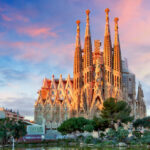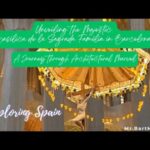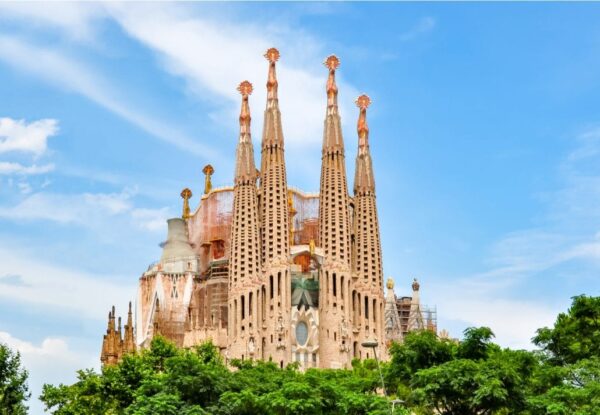
- The Architectural Marvel of Sagrada Familia: A Masterpiece by Gaudí
- Exploring the Symbolism Behind Sagrada Familia's Design
- Why Sagrada Familia is a Must-Visit Attraction in Barcelona
- Top Tips for Visiting Sagrada Familia: What You Need to Know
- The History and Significance of Sagrada Familia in Barcelona
- Capturing the Beauty of Sagrada Familia: A Photographer's Guide
The Sagrada Familia in Barcelona is not just a basilica; it's a masterpiece that embodies the genius of architect Antoni Gaudí. This stunning monument captivates visitors with its intricate facades, towering spires, and vibrant stained glass, making it an essential destination for anyone exploring the city.
In this article, we delve into The Extravagant Beauty of Sagrada Familia in Barcelona: Essential Information, highlighting its architectural significance, historical context, and practical tips for experiencing this extraordinary site. Join us as we uncover the secrets behind Gaudí's vision and the ongoing journey to complete this iconic landmark.
The Architectural Marvel of Sagrada Familia: A Masterpiece by Gaudí
The Sagrada Familia stands as an unparalleled architectural marvel that merges Gothic and Art Nouveau styles, showcasing Antoni Gaudí's innovative approach. Its intricate geometry and organic forms challenge traditional architectural conventions, allowing the basilica to resonate with the natural world. The use of natural light and vibrant colors through stained glass creates a mesmerizing atmosphere that changes throughout the day, inviting contemplation and awe.
One of the defining features of this masterpiece is its symbolic design. Each element, from the towering spires to the detailed facades, tells a story rooted in Christian theology. The Nativity Facade, for example, depicts the birth of Christ with a stunning array of sculptures that reflect Gaudí's deep spirituality and artistic vision. Additionally, the Passion Facade conveys themes of sacrifice and redemption, characterized by its stark, angular forms.
Visitors to the Sagrada Familia can explore its unique characteristics through a guided tour that highlights:
- Innovative Structural Techniques: Gaudí's use of hyperbolic paraboloids and catenary arches.
- Ecological Elements: Incorporation of natural motifs such as trees and plants.
- The Ongoing Construction: Insights into how modern technology aids in completing Gaudí's vision.
As the Sagrada Familia continues to evolve, it remains a testament to the timeless beauty of Gaudí's genius. The basilica not only represents a significant cultural and religious icon but also stands as a symbol of creativity and perseverance, as its completion is anticipated to be in the coming years. This grand structure will forever be a source of inspiration for architects and artists alike.
Exploring the Symbolism Behind Sagrada Familia's Design
The design of Sagrada Familia is rich in symbolism, with each element carefully crafted to convey deeper meanings. For instance, the basilica's twelve spires represent the twelve apostles, while the three grand facades—Nativity, Passion, and Glory—illustrate the life of Christ, emphasizing key moments in the Christian faith. This intricate layering of symbolism invites visitors to reflect on their own spiritual journeys.
Gaudí's vision also incorporates natural forms that resonate with the environment. The use of tree-like columns within the interior echoes a forest, creating a sense of tranquility and connection to nature. This approach not only enhances the aesthetic appeal but also symbolizes the unity of the divine with the natural world, reinforcing the idea that creation is a reflection of the Creator.
Visitors can explore this rich tapestry of symbols through a variety of architectural details, including:
- The Nativity Facade: Celebrating the birth of Jesus with lively sculptures and nature motifs.
- The Passion Facade: Depicting Christ’s crucifixion with stark, emotional expressions that convey suffering and sacrifice.
- The Glory Facade: Representing the resurrection and eternal life, characterized by its grand and uplifting design.
As exploration reveals the layers of meaning behind Sagrada Familia's design, it becomes clear that Gaudí's work is not just about visual beauty; it is also a profound spiritual narrative that continues to inspire and provoke thought in all who visit.
Why Sagrada Familia is a Must-Visit Attraction in Barcelona
The Sagrada Familia is an essential visit for anyone traveling to Barcelona due to its unparalleled architectural beauty and cultural significance. As a UNESCO World Heritage Site, it attracts millions of visitors each year, all eager to witness Gaudí's extraordinary vision come to life. The basilica's intricate details and unique design elements create an immersive experience that captivates both the eye and the spirit.
One of the reasons why the Sagrada Familia is a must-see is its unmatched artistry. Visitors can appreciate various features, including:
- Stunning Facades: Each facade showcases distinct themes and narratives, drawing you into the story of Christ's life.
- Vibrant Stained Glass: The colorful windows flood the interior with natural light, creating a kaleidoscope of colors that enhance the spiritual ambiance.
- Innovative Architecture: Gaudí's groundbreaking designs challenge conventional forms, offering a glimpse into the future of architectural creativity.
Furthermore, the Sagrada Familia serves as a living testament to Gaudí's dedication and passion for his craft. The basilica has been under construction for over a century, with completion projected in the coming years. This ongoing journey highlights the importance of perseverance in art and architecture, making the site a symbol of both artistic achievement and cultural heritage.
Lastly, the experience of visiting the Sagrada Familia transcends mere sightseeing. It invites reflection and contemplation, encouraging visitors to connect with both their spirituality and the artistry of human creation. The basilica stands as a beacon of inspiration, making it an unmissable highlight during your stay in Barcelona.
Top Tips for Visiting Sagrada Familia: What You Need to Know
When planning your visit to the Sagrada Familia, it's essential to book your tickets in advance online. This will not only save you time, allowing you to skip the long queues, but also ensure you secure a spot during your preferred time slot. Consider selecting a guided tour for a more enriching experience, as knowledgeable guides can provide insights into Gaudí's vision and the basilica's intricate details that you might otherwise overlook.
Another important tip is to visit early in the morning or later in the afternoon. These times usually see fewer tourists, offering a more peaceful experience to appreciate the extravagant beauty of the basilica without the hustle and bustle. Additionally, the changing light conditions at these times enhance the impact of the stunning stained glass windows, allowing you to fully immerse yourself in the atmosphere.
Don't forget to allocate enough time for your visit. The Sagrada Familia is vast, and there is much to explore beyond just the facades. We recommend taking at least two hours to wander through the interior and the surrounding areas. Make sure to check out the museum located on-site, which showcases the history of the basilica and Gaudí’s innovative techniques, deepening your appreciation of this architectural marvel.
Finally, be mindful of the dress code. As a place of worship, modest attire is expected when visiting the Sagrada Familia. Ensure your shoulders are covered and avoid wearing shorts or skirts that are too short. By respecting these guidelines, you contribute to the sanctity of the space and enhance your overall experience at this iconic location in Barcelona.
The History and Significance of Sagrada Familia in Barcelona
The Sagrada Familia’s history dates back to 1882 when construction began under architect Francisco de Paula del Villar. However, the iconic Gaudí took over in 1883, transforming the project with his unique vision and innovative techniques. His dedication to the basilica's design resulted in a fusion of Gothic and Art Nouveau styles, making it a masterpiece that continually captivates audiences worldwide.
Significantly, the Sagrada Familia is not only an architectural marvel but also a symbol of Barcelona's cultural identity. It reflects the city's rich heritage and artistic spirit, drawing millions of visitors each year. As a UNESCO World Heritage Site, its ongoing construction serves as a reminder of Gaudí's enduring legacy and the collaborative efforts of many artisans who contribute to its completion.
Moreover, the Sagrada Familia represents a profound spiritual journey, with each aspect of its design laden with religious symbolism. From the twelve spires symbolizing the apostles to the detailed representations of Christ's life across its facades, visitors are invited to explore both the artistic techniques and the deeper meanings behind Gaudí's work. This blend of artistry and spirituality enriches the experience for all who visit, making it a vital part of Barcelona's landscape.
As we look towards the future, the anticipated completion of the Sagrada Familia, expected in 2026, marks a significant milestone not only in architectural history but also in the cultural narrative of Spain. This grand basilica stands as a testament to human creativity, perseverance, and the ongoing quest for beauty, embodying the essence of Barcelona itself.
Capturing the Beauty of Sagrada Familia: A Photographer's Guide
For photographers seeking to capture the enchanting beauty of the Sagrada Familia, timing is crucial. The interplay of natural light throughout the day creates a dynamic canvas that transforms the basilica's features. Early morning or late afternoon visits are ideal for softer light, enhancing the vibrant colors of the stained glass and illuminating the intricate details of the facades. Observing how the light shifts can lead to stunning photographic opportunities.
When composing your shots, consider these essential tips for making the most of your photography session:
- Framing: Use the surrounding elements to frame the basilica, such as nearby trees or the bustling streets, to add context to your images.
- Angles: Experiment with various angles—shoot from below to emphasize the towering spires or find higher vantage points to capture the entire structure.
- Details: Focus on the intricate carvings and sculptures that adorn the facades, highlighting Gaudí's attention to detail and craftsmanship.
Additionally, consider using a tripod, especially in low-light conditions, to ensure stability and clarity in your photos. Long exposure shots can beautifully capture the movement of clouds against the backdrop of the Sagrada Familia, adding a dramatic effect to your images. It's also beneficial to explore the surrounding areas, as different perspectives can yield unique compositions that tell a richer story about this architectural wonder.
Finally, remember to respect the sacred nature of the site while photographing. Being mindful of your surroundings and other visitors will enhance your experience and allow for a more peaceful atmosphere to connect with the basilica's profound beauty. The Sagrada Familia is not just a subject for photography; it is an experience that invites you to engage deeply with its artistry and spirituality.
 The Completed Sagrada Familia: Immersive Beauty Unveiled
The Completed Sagrada Familia: Immersive Beauty Unveiled The Sagrada Familia: Unveiling the Architectural Marvel
The Sagrada Familia: Unveiling the Architectural Marvel Sagrada Familia in Barcelona: Essential Information and Tips
Sagrada Familia in Barcelona: Essential Information and TipsIf you want to know other articles similar to The Extravagant Beauty of Sagrada Familia in Barcelona: Essential Information you can visit the category WHERE YOU CAN GO.
Deja una respuesta










Read more!